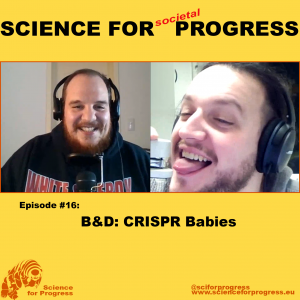Podcast: Play in new window | Download (Duration: 37:06 — 17.0MB)
Subscribe: Google Podcasts | RSS | More

At the end of November 2018, Chinese scientist He Jiankui announced that he had genetically modified human embryos which were then brought to term. The resulting twin sisters appear to be healthy. But this experiment was not greeted with enthusiasm by the scientific community.
The critique attacks every aspect of the experiment: the treatment’s medical necessity, the reasoning behind the treatment approach, the way it was conducted, the ethical implications, and it also wasn’t legal.
He Jiankui was aware that he was doing something the public and the scientific community would not agree with. In order to dampen the fall, He announced his experiments in a series of YouTube videos in which he also attempts an ethical justification. He addressed the public in this way before the scientific community could comment, to frame the following discussion in his favor. Possibly also to force Chinese authorities to act cautiously with the eyes of the world resting on He Jiankui.
After an appearance at a conference in Hong Kong, He Jiankui went missing, and it still seems to be unclear where he is. Some news outlets reported the Dr. He was put under house arrest.
In this episode, Bart Geurten (@BartGeurten) and I (Dennis Eckmeier, @DennisEckmeier) have a conversation about what we understand about what happened. (Recorded Dec 16th, 2018)
What Happened?
He Jiankui is a geneticist who works on genetic alteration of human embryos. In some countries, scientists can get permission to experiment on human embryos when the embryos are just a few cells big. Such embryos, however, may not be allowed to develop into full human beings. The goal of such experiments is, for example, to establish safer methods for gene therapies.
The embryos are created through in-vitro-fertilization, an established practice for couples who are having trouble having healthy babies. Eggs and sperms are brought together outside the woman’s body, and the growing embryos can be tested for possible gene defects. Healthy embryos can then be implanted in the becoming mother’s womb.
But He implanted genetically modified embryos in the womb of a woman, which the scientific community has many problems with. The two embryos have become babies and were born several months before the announcement.
What exactly did He Jiankui try to achieve?
He Jiankui wants to protect children of HIV infected parents from infection, AIDS, and social discrimination that comes with HIV infection.
The medical community, however, does not agree that gene modification would be an appropriate method to accomplish this. There are numerous ways to protect yourself from infection with HIV by following simple rules of caution.
He chose couples where the father is HIV positive, while the mother is not. To protect the mother, such couples can use in vitro fertilization, if they want a child. In the process of IVF, the HIV is removed.
Was the treatment well designed?
So there was no medical necessity for this treatment. But let’s say there would have been. To genetically protect the children from HIV, He Jiankui attempted to change a gene (CCR5) to a specific variant (delta32) that is believed to play a role in HIV resilience.
But the scientific community agrees that they don’t know enough about the gene’s function. Genes code for proteins, and the same protein may play different roles in different bodily functions. Besides it’s implication in HIV resilience, the delta32 variant of CCR5 seems to be just as likely to increase vulnerability to influenza and the West Nile virus. There seems to be one study that even claims it might play a role in increasing cognitive ability. If the experiment worked, He may have introduced human enhancement which he himself says would be unethical. Or he may have put the girls at an increased risk to die from the flu.
This means that this was a highly risky experiment and He may have done more harm than good to the children.
Did He Jiankui make the alterations he wanted?
No, the experiment wasn’t successful. Genes occur several times in the genome. In order for the genetic modifications to be effective, all these copies need to be changed. But this doesn’t seem to have worked. Instead one of the twins will have both variants of the protein expressed in all her cells. The other twin will have cells that will produce either one or the other protein variant.
On top of it, He wasn’t successful in recreating the delta32 version of the gene. He created completely new mutations of the CCR5 gene, and we have no idea what this will mean for the twin girls.
Did the parents know what they signed up for?
We don’t know. Consent is not a simple issue. There are many ways to nudge someone into signing something. Especially if you are promising future parents a better life for their children while downplaying the risks and experimental nature of an untested therapy. Since He Jiankui went behind the backs of his own institute, and everybody else, really, nobody was there to ensure proper protocol was followed.
B&D conversation
Bart and Dennis further share their thoughts about human gene modification in more general terms.
Do you have questions, comments or suggestion? Email info@scienceforprogress.eu, write us on facebook or twitter, or leave us a video message on Skype for dennis.eckmeier.

sources:
• Ed Yong, The Atlantic
• Hank Green, SciShow
• He Jiankui at Human Genome Editing Sumit
• He Lab YouTube videos
• Kurzgesagt – In a Nutshell: Genetic Engineering Will Change Everything Forever – CRISPR